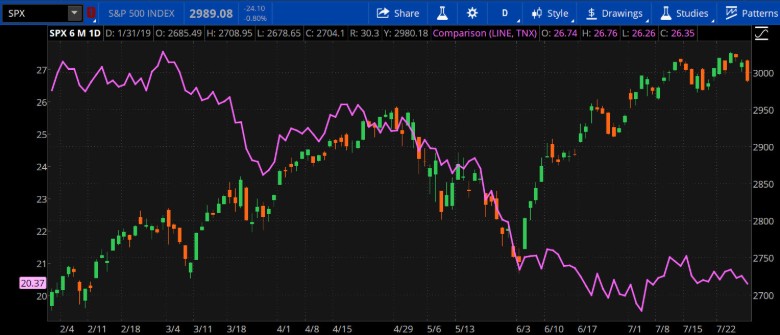After a decade without cutting interest rates, the Fed announced a quarter-point easing Wednesday and also ended its balance sheet reduction program earlier than expected.
However, stocks fell sharply after the decision, possibly because in its post-meeting statement and press conference, the Fed didn’t indicate any real intention of more cuts in the near future. That might leave some investors wondering if this is a “one and done” move.
At his press conference, Fed Chairman Jerome Powell might have reinforced that impression when he said, “We’re thinking of (the rate cut) as a mid-cycle adjustment to policy” in light of weak overseas growth and a slower manufacturing environment that might impact the Fed’s favorable economic outlook. That wasn’t necessarily what bulls wanted to hear, as Powell seems to be retreating back to watching data come in rather than painting a picture of more cuts to come.
In summary, this doesn’t sound like the Fed is starting any sort of long-running rate-cut cycle. Powell basically said as much in his press conference. That’s probably one reason stocks are down 1% in the hour after the decision.
The short-term benchmark rate now drops to a range between 2% and 2.25%, back where it was before the Fed raised rates last December. The Fed said it based Wednesday’s decision on “the implications of global developments for the economic outlook” along with muted inflation pressures. Though the U.S. economy has grown a bit more strongly than some analysts had expected, overseas economies look sluggish, so that appears to have affected the Fed’s thinking.
However, two members of the Federal Open Market Committee (FOMC) voted against a rate cut, which is an unusually high number, according to analysts. Also, the statement didn’t really provide much spin on what the Fed might do next. Instead, it looks like the Fed might retreat to its “wait and see” attitude of earlier this year. Bulls who pushed stock prices to record highs going into the meeting might feel disappointed to see the statement not predict more cuts in the near future.
All the Fed said about its next steps is that it would “continue to monitor the implications of incoming information for the economic outlook and will act as appropriate to sustain the expansion…” That wasn’t really changed from its last statement in June when it kept rates unchanged.
In assessing the economy, the Fed pretty much stuck to previous language, too. Business spending remains soft even though consumer spending has picked up, the Fed said. Economic activity has been rising “at a moderate rate.” Inflation expectations haven’t changed, and uncertainty about the economic outlook remains.
At the start of his press conference, Powell didn’t depart from the Fed’s statement regarding the future path of rates. He said “it’s important to sustain the expansion,” but said the rate cut supports household and business confidence through lower borrowing costs. Financial conditions and confidence have moved up since the Fed indicated in June that it was preparing to cut rates, he added.
Remember that last month, in the Fed’s “dot plot,” seven of 17 Fed officials indicated they believed rates would be a half-point lower by the end of 2019. Now they’ve fallen a quarter-point, so the question is what’s next? Futures prices have built in a more than 90% chance for at least one more rate cut, and a better than 50% chance for two or more rate cuts after this one. We’ll see how that changes now that Powell has spoken.
Today’s rate cut ends the second-longest stretch in history without the Fed easing rates. It’s been 3,878 days since the Fed last did this, second only to a 4,115-day streak between 1942 and 1954, according to MarketWatch.
Earlier in July, there was a period of a few days when the futures market started pointing toward the chance of a 50-basis point cut. That faded quickly after Fed speakers pushed back and made clear that such a dramatic move was unlikely.
Lack of a 50-point move today, which wasn’t widely expected, might also explain the market’s initial less than rosy reaction. There might have been a certain number of investors who’d hoped the Fed would make a more dramatic slice.
Muted Inflation Provides Cover for Rate Cut
Even cutting rates by 25 points with the economy growing at a 2% clip, consumer confidence strong, and the stock market at all-time highs isn’t something all FOMC voters support, judging from their recent comments and the two dissenters on Wednesday. However, with core inflation up just 1.6% year-over-year, the Fed still hasn’t reached its 2% inflation goal. Perhaps a rate cut could nudge things back in that direction.
Everyone focuses on inflation, but the Fed’s mandate for price stability means it doesn’t want deflation, either. For an example of how deflation can hurt a country, look at Japan’s economic performance since 1990.
Also, the low inflation represents kind of a green light for the Fed. With headline inflation not really a factor and consumer inflation expectations below 3% a year, it gives the Fed a longer runway to reduce rates without necessarily triggering fears of a 1970s-style price explosion developing.
The drawback of easing rates here, however, is that it gives the Fed less leverage to lower them more if the economy actually hits a recession. When the Fed began cutting rates in 2007, it started with the Fed funds rate above 5%. That’s way above the 2.25% to 2.5% level it’s cutting from now.
Domestic Rates and Global Impact
Another reason the Fed faced pressure to cut is the situation in Europe, where rates are negative and hit historic lows this month. Higher borrowing costs here could conceivably put companies and consumers at a disadvantage vs. competitors in Europe.
A high-flying dollar, helped by the weak European economy and Brexit worries, is also something that conceivably could lose some altitude if U.S. rates fall. Some U.S. companies reporting Q2 earnings have cited dollar strength as a headwind for their international business. The dollar recently traded at more than two-year highs vs. the British pound and the euro is at two-year lows vs. the dollar.
One school of thought suggests the Fed might be holding back on a deeper cut because it wants to see how trade talks with China go during the weeks heading into the September FOMC meeting. A real trade deal that puts this long-term drag on the economy to bed would likely serve as another rate cut in terms of juicing the market, and Fed officials might be hesitant to cut rates too much if a deal does appear imminent. That isn’t the case now, but things can change.
The Balance Sheet’s “New Normal?”
With the market focused on the 25-basis point reduction in the Fed funds rate, seemingly lost in the conversation is the announcement that Powell & Company plan to end the balance sheet reduction program two months earlier than originally planned. Recall that prior to the 2008-09 recession, the central bank kept about $800 billion in securities on its balance sheet. By 2014 that number had ballooned to $4.5 trillion, where it sat for 4 years until the start of the current wind-down in late 2017.
The speed at which the Fed turned from hawk to dove on the Fed funds rate seems to have spilled over into its balance sheet normalization plan as well. Perhaps this implies a “new normal” in terms of its asset baseline.
Recall that when the Fed ended its tightening phase, declaring a “neutral rate,” it wasn’t too long before the calls began for rate cuts. Once the balance sheet reaches its supposed neutral rate—perhaps around $3.7 trillion—might a new round of balance sheet expansion be just around the corner?
The rate cut erases the last rate hike done back in December. Markets fell nearly 20% in Q4 as investors anticipated that move, but then bounced back with a sizzling first-half performance in 2019 as Powell and company said they’d be “patient” with rates and then started to hint about a rate cut this spring. The S&P 500 Index (SPX) was up 20% year-to-date going into today’s decision, and it’s probably fair to say a lot of that is due to the Fed. It’s not likely due to earnings growth, which has been almost non-existent overall.

FIGURE 1: STOCKS, YIELDS FALL ON RATE CUT. Hints of a one-and-done rate cut disappointed the broader market, sending the S&P 500 (SPX) down in late trading. But an announced early end to the Fed’s balance sheet reduction program helped initially weigh on long rate yields. Data Source: Cboe, S&P Dow Jones Indices.Chart source: The thinkorswim® platform from TD Ameritrade. For illustrative purposes only. Past performance does not guarantee future results.
Sector Impact Worth Monitoring: With the rate cut, some sectors that might be worth watching include the dividend payers like Health Care, Staples, and Utilities. At this point, the average dividend yield for the SPX is 1.86%, and the 10-year Treasury yield remains just above that at around 2.02%. When the Fed cuts rates, there’s a chance for more pressure on Treasury yields, potentially making high-yield stocks more attractive to some investors. Yields on the so-called “defensive” stocks in the sectors mentioned above tend to be higher than the SPX average and in many cases are well above the 10-year. That means investors who otherwise might put money into bonds could consider stocks instead.
Cyclical sectors that tend to do better in a strong economic environment, including Industrials, Technology, Consumer Discretionary, and Financials could also get a tailwind from a rate cut on hopes that lower borrowing costs could stimulate more consumer spending. For instance, lower rates on car loans could help automobile companies, well consumer goods companies making big-ticket items that people tend to borrow money for like dishwashers and ovens could also benefit.
Is Nap Time Over? From a broader perspective, a rate cut might help wake the market from its summer snooze. As The Wall Street Journal pointed out Tuesday, the SPX hasn’t had a 1% move in either direction for 35 trading days, the longest such streak since June to October 2018 when it went 74 days without a 1% move. That’s not a prediction, of course. It’s just as possible that with the rate cut out of the way, stocks might go on an August vacation. We’ll have to wait and see if today’s move holds, with the SPX down 1% in the hour after the rate cut.
What A Rate Cut Might NOT Affect: Some industries and sectors might get less help from lower rates than others. Housing, for instance, has already been benefiting from lower mortgage rates over the last six months and it’s not sure how much that’s actually helped (see more below). Regional banks, which tend to rely on lending money out at higher borrowing costs, could also be in the hot seat with a rate cut threatening their profit margins.
Today’s rate cut might not have too big an impact on mortgage rates, some analysts said, because it’s focused on the short end of the yield curve. Construction spending data for July due tomorrow morning could be the next number to watch in housing. Analysts expect solid monthly growth of 0.4%, according to Briefing.com.
Good Trading,



